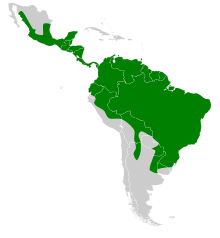Little yellow-shouldered bat
The little yellow-shouldered bat (Sturnira lilium) is a bat species from South and Central America. This species is a frugivore and an effective seed disperser.[2][3] It roosts alone in tree cavities, on branches, vines, and under palm leaves, usually keeping to the same roosts day to day.[4][5] There is evidence to suggest hypothermia is a thermoregulatory strategy to help adjust metabolic levels.[6] In terms of mating, ambient temperature has been noted as a greater influence as compared to food availability.[7] Its wing shape can also be affected by pregnancy in order to make flight more efficient.[8]
| Little yellow-shouldered bat | |
|---|---|
 | |
| Scientific classification | |
| Kingdom: | Animalia |
| Phylum: | Chordata |
| Class: | Mammalia |
| Order: | Chiroptera |
| Family: | Phyllostomidae |
| Genus: | Sturnira |
| Species: | S. lilium |
| Binomial name | |
| Sturnira lilium Geoffroy, 1810 | |
 | |
Gallery
 Little yellow-shouldered bat Wingspan
Little yellow-shouldered bat Wingspan Little yellow-shouldered bat teeth (mature female)
Little yellow-shouldered bat teeth (mature female) Little yellow-shouldered bat wingspan (transparent) (mature female)
Little yellow-shouldered bat wingspan (transparent) (mature female)
gollark: Hello!
gollark: Electoral fraud 929% successful.
gollark: As planned.
gollark: HelloBoi will now be arrested by the [LOCATION] police.
gollark: Score voting and STAR voting also seemingly cool?
References
- Velazco, P. & Patterson, B. (2017). "Sturnira lilium". IUCN Red List of Threatened Species. 2017: e.T88159688A22049384. doi:10.2305/IUCN.UK.2017-2.RLTS.T88159688A22049384.en.
- Silva, Wesley R.; Kalko, Elisabeth K. V.; Mello, Marco A. R. (2008-04-18). "Diet and Abundance of the Bat Sturnira lilium (Chiroptera) in a Brazilian Montane Atlantic Forest". Journal of Mammalogy. 89 (2): 485–492. doi:10.1644/06-MAMM-A-411R.1. ISSN 0022-2372.
- Silva, Wesley Rodrigues; Kalko, Elisabeth Klara Viktoria; Mello, Marco Aurelio Ribeiro (March 2008). "Movements of the bat Sturnira lilium and its role as a seed disperser of Solanaceae in the Brazilian Atlantic forest". Journal of Tropical Ecology. 24 (2): 225–228. doi:10.1017/S026646740800480X. ISSN 1469-7831.
- Evelyn, Michelle J.; Stiles, David A. (2003). "Roosting Requirements of Two Frugivorous Bats (Sturnira lilium and Arbiteus intermedius) in Fragmented Neotropical Forest1". Biotropica. 35 (3): 405–418. doi:10.1111/j.1744-7429.2003.tb00594.x. ISSN 1744-7429.
- Fenton, M. B.; Vonhof, M. J.; Bouchard, S.; Gill, S. A.; Johnston, D. S.; Reid, F. A.; Riskin, D. K.; Standing, K. L.; Taylor, J. R. (2000). "Roosts Used by Sturnira lilium (Chiroptera: Phyllostomidae) in Belize1". Biotropica. 32 (4a): 729–733. doi:10.1111/j.1744-7429.2000.tb00521.x. ISSN 1744-7429.
- Audet, D.; Thomas, D. W. (1997-02-01). "Facultative hypothermia as a thermoregulatory strategy in the phyllostomid bats, Carollia perspicillata and Sturnira lilium". Journal of Comparative Physiology B. 167 (2): 146–152. doi:10.1007/s003600050058. ISSN 1432-136X. PMID 9120068.
- Mello, M.A.R.; Kalko, E.K.V.; Silva, W.R. (2009-02-26). "Ambient temperature is more important than food availability in explaining reproductive timing of the bat Sturnira lilium (Mammalia: Chiroptera) in a montane Atlantic Forest". Canadian Journal of Zoology. 87 (3): 239–245. doi:10.1139/Z09-010. ISSN 0008-4301.
- Oliveira, Hernani F. M. de; Camargo, Nícholas F. de (2012-11-14). "Sexual Dimorphism in Sturnira lilium (Chiroptera, Phyllostomidae): Can Pregnancy and Pup Carrying Be Responsible for Differences in Wing Shape?". PLOS One. 7 (11): e49734. Bibcode:2012PLoSO...749734C. doi:10.1371/journal.pone.0049734. ISSN 1932-6203. PMC 3498221. PMID 23166759.
This article is issued from Wikipedia. The text is licensed under Creative Commons - Attribution - Sharealike. Additional terms may apply for the media files.
